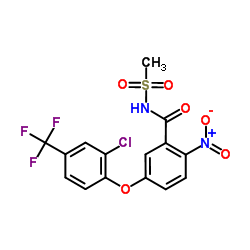Liver preneoplastic changes in mice treated with the herbicide fomesafen.
J Krijt, P Stránská, J Sanitrák, A Chlumská, F Fakan
Index: Hum. Exp. Toxicol. 18(5) , 338-44, (1999)
Full Text: HTML
Abstract
1. Effect of the diphenyl ether herbicide fomesafen on liver preneoplastic changes and porphyrin biosynthesis was examined in male C57BL/6J mice (0.23% in the diet for 14 months) and ICR mice (0.3% in the diet for 50 weeks). Fomesafen treatment resulted in preneoplastic changes (liver nodules and foci of altered hepatocytes) in both strains, uroporphyria developed only in ICR mice. 2. Iron pretreatment (600 mg/kg as a single dose) accelerated the development of fomesafen-induced preneoplastic changes in both mouse strains. The number of foci containing altered hepatocytes, as well as the number and size of liver nodules, were increased in iron-pretreated animals. 3. A single injection of iron induced marked uroporphyria in C57BL/6J mice after 14 months (liver porphyrin content 102 nmol/g). This uroporphyria was further potentiated by fomesafen administration (208 nmol/g). 4. In ICR mice, liver histology was apparently normal after a 3 month recovery from fomesafen treatment (0.32% for 9 months). Liver porphyrin content (260 nmol/g) started to decrease immediately after fomesafen withdrawal, but was still significantly elevated after 3 months (5 nmol/g), as compared to controls (1 nmol/g). 5. It is concluded that the toxicological evaluation of fomesafen should focus on liver porphyrin biosynthesis.
Related Compounds
| Structure | Name/CAS No. | Molecular Formula | Articles |
|---|---|---|---|
 |
Fomesafen
CAS:72178-02-0 |
C15H10ClF3N2O6S |
|
The effect of protoporphyrinogen oxidase inhibitors on micro...
1995-12-01 [Obes. Res. 3 Suppl 5 , 785S-788S, (1995)] |
|
Occurrence and distribution of sulfonylurea and related herb...
2011-10-01 [Bull. Environ. Contam. Toxicol. 87(4) , 420-5, (2011)] |
|
Experimental hepatic uroporphyria induced by the diphenyl-et...
2003-05-15 [Toxicol. Appl. Pharmacol. 189(1) , 28-38, (2003)] |
|
Effect of a toxicant on phagocytosis pathways in the freshwa...
2008-07-01 [Cell Tissue Res. 333(1) , 147-58, (2008)] |
|
Circadian response of annual weeds in a natural setting to h...
2003-03-01 [Chronobiol. Int. 20(2) , 299-324, (2003)] |